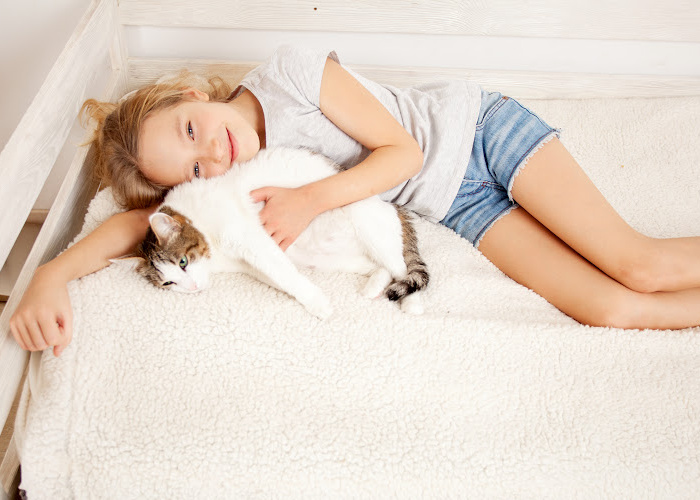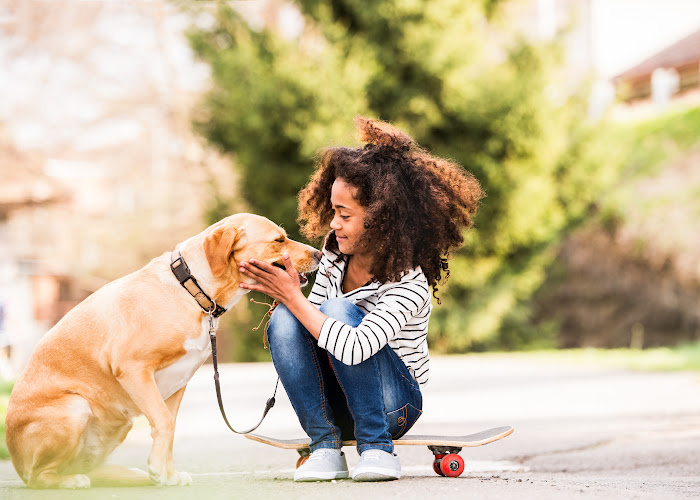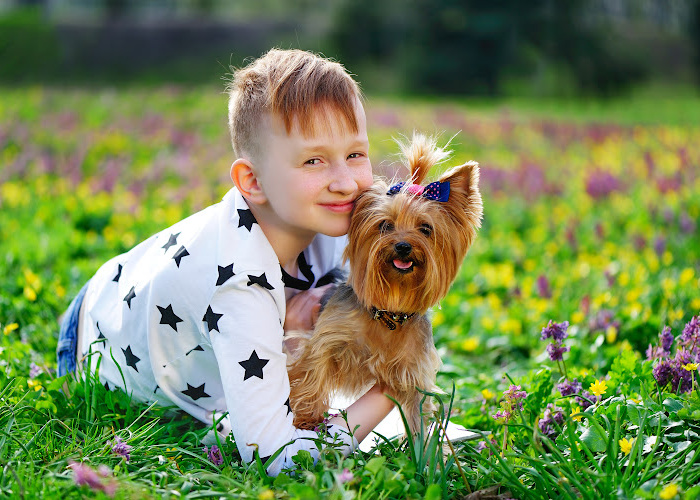It's crucial to know that students with autism and ADHD need special study strategies. Autism…

What is the Best Pet for an Autistic Child?
For families considering pets for children with autism, it’s crucial to identify a companion that aligns with their unique needs. Not all pets are created equal, especially when it comes to providing support for someone on the autism spectrum. The right choice can make all the difference, as studies show that animals in the home often serve as therapeutic supports for an autistic child. But, what is the best pet for an autistic child?
From therapy pets for autistic children to daily furry friends, animals such as dogs, cats, guinea pigs, and rabbits not only provide companionship but also aid in emotional and social development. The calming effect of a pet’s presence can lead to minimized stress and fewer meltdowns, making the task of choosing a pet for an autistic child one of great importance and potential benefit.
When we talk about the autistic child best pet, we envision an animal that effortlessly integrates into their routine, creating a sense of harmony and fostering growth in ways that go beyond words. Discover how finding the right pet can help unlock doors to a fuller, more joyous life for your child with autism.

The Therapeutic Benefits of Pets for Autistic Children
The companionship of a pet can bring significant improvements to the daily lives of autistic children. From providing emotional support to assisting with social skills development, pets can offer varied therapeutic advantages that enrich the lives of those with autism. Specifically, animals have been recognized for their role as calming agents, facilitators for social and emotional learning, and sources of unconditional love and support.
The Calming Influence of Animals on Autistic Kids
One of the standout benefits of pets for autistic kids is their ability to induce tranquility. Studies highlight that interacting with pets can help reduce anxiety levels and blood pressure. Service animals for autistic children are often trained to provide comfort during stressful times, using techniques such as weighted pressure to help anchor emotions during sensory overloads or meltdowns.
Developing Social and Emotional Skills Through Pet Interaction
Furthermore, engagement with pets can contribute to the development of critical social and emotional abilities. Autistic children, who may find traditional social interactions daunting, can use the nonverbal communication offered by companion animals for children with autism to build confidence in their social dealings.
Pets as a Source of Unconditional Love and Support
Autistic children often resonate with the non-judgmental nature of pets, which brings about comfort and a sense of security. Autism-friendly pets can act as steady emotional anchors, offering unwavering support and helping to alleviate loneliness.
Recommended pets for autistic children should ideally possess a calm temperament, facilitating a nurturing environment that supports emotional development and the expression of feelings through a bond that fosters dependability and companionship.

Selecting the Right Pet for a Child with Autism
Embarking on the journey of selecting the right pet for a child with autism is a deeply personal and rewarding decision, filled with potential for enhancing the life of your child. When choosing a pet for an autistic child, the compatibility between the pet and the child, as well as the entire family, is a primary consideration.
This choice isn’t just about affection, it’s about finding a companion that can meet the child’s specific needs while also adapting to the lifestyle and emotional fabric of the household. It’s not a decision to be taken lightly as owning a pet is a long-term commitment, and when it comes to therapy pets for autistic children, the nuanced benefits can be incredibly significant.
Understanding the Long-term Commitment to Pet Ownership
Commitment to pet ownership goes beyond providing the basics such as food, shelter, and veterinary care. For families considering autism-friendly pets, it’s important to reflect on the time and resources you can dedicate to training, socializing, and cultivating a nurturing environment for both the pet and child.
Autism can present unique challenges that necessitate thoughtful preparation, such as creating a calm, structured environment where the pet can thrive and become a steadfast companion animal for children with autism. Acknowledging this commitment is instrumental in ensuring a successful and enriching relationship that extends for years.

Emphasizing the Individual Needs of Each Child
Autistic children are as diverse and individualistic as the pets that can come into their lives. Consequently, when choosing a pet for an autistic child, identifying a pet that aligns with the child’s sensitivities is paramount. For instance, a child with sensory sensitivities may resonate more with the serene nature of a quiet cat rather than the exuberant energy of a puppy.
Additionally, introducing a pet should encourage responsibility and interaction in ways that align with the child’s capabilities, fostering growth and confidence.
Sharing the Joy and Responsibility of a Family Pet
The addition of a pet to your family should be a source of shared joy as well as a teaching moment for your child. It provides an avenue for autistic children to learn empathy and responsibility while caring for a pet, reinforcing concepts such as routine and respect for other living beings.
Also, it’s important for families to embrace the concept of a family pet underscoring the idea that if at any point the child’s interest wavers, the family is prepared to step in and ensure the continued well-being and care of the pet. In its totality, owning a pet presents an invaluable chance to enrich the lives of everyone involved, creating lasting memories and profound connections.
Selecting the Right Pet for a Child with Autism
What factors should be considered when choosing a pet for a child with autism?
When choosing a pet for a child with autism, consider the child’s sensitivity to noise, their interest in particular animals, their ability to handle and care for a pet safely, and the pet’s temperament. A pet that is calm, predictable, and has a friendly nature is usually a good choice. It’s also crucial to ensure the pet’s personality is compatible with the child’s needs.
Are there specific types of pets that are better suited for children with autism?
Dogs and cats are popular choices due to their ability to form strong bonds and provide comfort. However, quieter animals like guinea pigs and rabbits can also be excellent companions for autistic children, as they require less maintenance and can be soothing. Therapy pets, specifically trained to work with autistic children, can also be beneficial.
How do pets provide a calming influence for autistic children?
Pets can have a calming effect on autistic kids, potentially reducing stressful outbursts and providing comfort during overwhelming situations. Interactions with pets can lower blood pressure and produce a soothing effect, making them excellent companions for managing anxiety and stress.
Can pets really help autistic children develop social and emotional skills?
Yes, pets can help autistic children enhance social behaviors, like initiating conversation and responding to social cues. They serve as ‘social lubricants,’ easing interactions with peers and adults. Caring for a pet can also foster empathy, compassion, and an understanding of nonverbal communication cues.
In what ways do pets offer unconditional love and support to autistic children?
Pets offer a non-judgmental presence, providing consistent and unconditional love to autistic children. They accept and engage with kids without pressuring them to communicate in traditional human ways. This unconditional support can lead to emotional well-being and reduce feelings of loneliness.
What are the long-term commitments to consider when getting a pet for an autistic child?
Prospective pet owners need to consider the financial implications of pet ownership, time devoted to pet care, and the responsibilities associated with everyday tasks. Training for both the child and pet to ensure safe interactions, as well as a plan for if the child loses interest, are essential components when bringing a pet into the family.
How should a child’s individual needs be considered when selecting a pet?
It’s important to match the pet’s characteristics with the child’s sensitivities, such as choosing a quieter pet for a noise-sensitive child or one with a soft coat for a child with touch sensitivities. The child’s interest in certain animals should also guide the decision, ensuring that the pet can be cared for appropriately and safely by the child.
How can families share the joy and responsibility of caring for a pet with an autistic child?
Families can involve the autistic child in the daily care of the pet to teach them about empathy, responsibility, and maintaining routines. It is also important for the family to be ready to take over the care of the pet if the child’s interest wanes, ensuring the animal’s well-being is always maintained as part of the family.



This Post Has 0 Comments